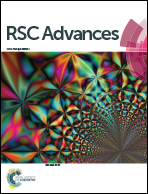CuS–Bi2S3 hierarchical architectures: controlled synthesis and enhanced visible-light photocatalytic performance for dye degradation†
Abstract
Novel CuS–Bi2S3 heterojunctions were fabricated by a one-step solvothermal method using glycol as solvent and L-lysine as structure-directing reagent. By varying the sulfur sources, CuS–Bi2S3 composites of different morphologies were obtained. Novel microspheres composed of ultrathin nanosheets and radial nanoneedles were synthesized using potassium thiocyanate (PT) and thiourea (TU) as sulfur sources, respectively. Based on the experimental and characterization results, we proposed a step-by-step mechanism for the growth of the CuS–Bi2S3 hierarchical architectures based on the different release rates of S2− in the preparation process. It was observed that the CuS–Bi2S3 nanocomposites show high photocatalytic activity for the degradation of dyes (Rh-B and CV, as well as both of them in an aqueous solution) under visible light (λ ≥ 400 nm), showing performance much higher than those reported in the literature. In terms of sulfur precursors, the degradation rates can be arranged in the following order: TU > PT > ST > SS, and the optimal conditions for composite preparation are a crystallization time of 6 h and a Bi/Cu molar ratio of 10 : 1. The good photocatalytic activity is attributed to the matching of the CuS and Bi2S3 band-gap energies as well as the CuS/Bi2S3 interfaces that facilitate transfer and separation of photogenerated charge carriers. With high stability, the CuS–Bi2S3 composites have high potential for the photodegradation of dyes in water-treatment processes.


 Please wait while we load your content...
Please wait while we load your content...